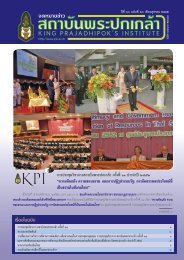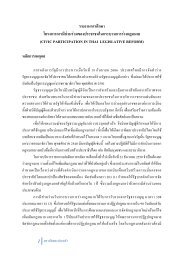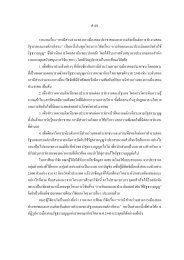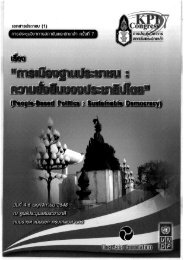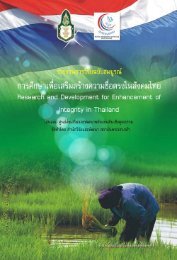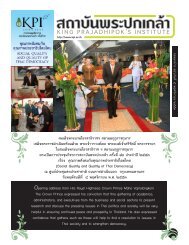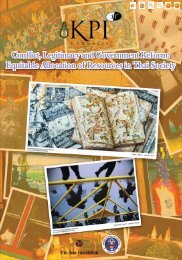SUFFiciENcy EcONOMy ANd GRASSROOtS DEvElOPMENt
SUFFiciENcy EcONOMy ANd GRASSROOtS DEvElOPMENt
SUFFiciENcy EcONOMy ANd GRASSROOtS DEvElOPMENt
Create successful ePaper yourself
Turn your PDF publications into a flip-book with our unique Google optimized e-Paper software.
218<br />
The Meaning of Sufficiency Economy <br />
International Conference<br />
Map of Northeastern Thailand (Khorat Plateau)<br />
Map showing Ban Nông Tün, Tambon Khwao, Muang District, Mahasar<br />
akham Province, 1963<br />
Ban Nông Tün, the village in Tambon Khwao, M?ang District, Mahasa<br />
rakham province we chose to live and carry out research in, is located in the center<br />
of the Isan heartland. We have had the opportunity to carry out restudies in the<br />
village in 1980-83 and again in 2005 and have visited the village many times in<br />
between and since. Our most recent visit was on December 25 th , 2007. 4<br />
A Small Rural World in the early 1960s<br />
In the early 1960s Ban Nông Tün was a rather remote, quiet rural community<br />
whose economy was nearly self-sufficient. <br />
Main street of Bãn Nông Tün, 1963 (photo by Charles Keyes)<br />
The primary social unit of the village was a household which usually consisted<br />
of a husband and wife and their unmarried children, but which, following local<br />
custom, could also include a son-in-law since men settled after marriage with their<br />
wives. Like all rural communities in Northeastern Thailand at the time, Ban Nông<br />
Tün was a village of children and young people.Families lived in houses built of loc<br />
ally-available materials, with the exception in many houses that used corrugatediron<br />
roofing.<br />
In our first household census, we found that there were 119 households with a<br />
total of 700 people, or an average of 5.9 people per household. Like rural people<br />
throughout the Northeast at this time, Ban Nông Tün villagers had experienced a <br />
significant increase in birth rates over the previous decades. For the decade prior to<br />
1920 the rate of population growth for the whole of northeastern Thailand was<br />
approximately 2.0% per annum; it rose to 2.7% per year for the period of the 1920s<br />
and increased again to 3.3% for the decade between 1930 and the 1940s, the rate<br />
declined to 2.9% and then rose again to 3.1% in the 1950s and 3.4% in the 1960s. 5 <br />
Villagers lived a life defined primarily by relations between kinsmen for<br />
producing the basic necessities of life and between fellow villagers for addressing<br />
moral and religious concerns. In 1963-64, villagers in Ban Nông Tün were engaged<br />
in producing primarily for their own consumption. Rice was cultivated using labor<br />
intensive methods. Plowing and harrowing of fields was done using water buffaloes.<br />
4<br />
We have been assisted in our research after our initial study by several colleagues – Suriya<br />
Smutkupt, Paitoon Mikusol, and Bussarawan Teerawichitchainan – and want to acknowledge their<br />
significant contributions to our research. Most of all we want to thank people of Ban Nông Tün for t<br />
heir tolerance of two farang who in January 1963 decided to make themselves part of their lives. We<br />
are especially grateful to the late Ngao Khamwicha (1935-1991), his wife, Nuan, and his daughter,<br />
Watsana, and their families, who have welcomed us into their homes in the village.<br />
5<br />
Population figures used for calculating these percentages have been taken, in part, from<br />
Lefferts (1974:62)



